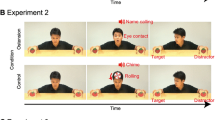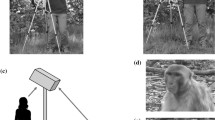Abstract
Many primate species reliably track and follow the visual gaze of conspecifics and humans, even to locations above and behind the subject. However, it is not clear whether primates follow a human’s gaze to find hidden food under one of two containers in an object-choice task. In a series of experiments six adult female chimpanzees followed a human’s gaze (head and eye direction) to a distal location in space above and behind them, and checked back to the human’s face when they did not find anything interesting or unusual. This study also assessed whether these same subjects would also use the human’s gaze in an object-choice task with three types of occluders: barriers, tubes, and bowls. Barriers and tubes permitted the experimenter to see their contents (i.e., food) whereas bowls did not. Chimpanzees used the human’s gaze direction to choose the tube or barrier containing food but they did not use the human’s gaze to decide between bowls. Our findings allowed us to discard both simple orientation and understanding seeing-knowing in others as the explanations for gaze following in chimpanzees. However, they did not allow us to conclusively choose between orientation combined with foraging tendencies and understanding seeing in others. One interesting possibility raised by these results is that studies in which the human cannot see the reward at the time of subject choice may potentially be underestimating chimpanzees’ social knowledge.
Similar content being viewed by others
References
Anderson JR, Sallaberry P, Barbier H (1995) Use of experimenter-given cues during object-choice tasks by capuchin monkeys. Anim Behav 49:201–208
Anderson JR, Montant M, Schmitt D (1996) Rhesus monkeys fail to use gaze direction as an experimenter-given cue in an object-choice task. Behav Proc 37:47–55
Bateson MC (1979) The epigenesis of conversational interaction: a personal account of research development. In: Bullowa M (ed) Before speech. Cambridge University Press, Cambridge, pp 63–77
Butterworth G (1991). The ontogeny and phylogeny of joint visual attention. In: Whiten A (ed) Natural theories of mind. Blackwell, Oxford, pp 223–232
Butterworth G, Cochran E (1980) Towards a mechanism of joint visual attention in human infancy. Int J Behav Dev 3:253–272
Call J, Tomasello M (1994) Production and comprehension of referential pointing by orangutans (Pongo pygmaeus). J Comp Psychol 108:307–317
Call J, Tomasello M (1996) The effect of humans on the cognitive development of apes. In: Russon AE, Bard KA, Parker ST (eds) Reaching into thought. The minds of the great apes. Cambridge University Press, Cambridge, pp 371–403
Call J, Tomasello M (1998) Distinguishing intentional from accidental actions in orangutans (Pongo pygmaeus), chimpanzees (Pan troglodytes), and human children (Homo sapiens). J Comp Psychol 112:192–206
Call J, Tomasello M (in press) A nonverbal theory of mind test. The performance of children and apes. Child Dev
Campos J, Stenberg C (1981) Perception, appraisal, and emotion: the onset of social referencing. In: Lamb M, Sherrod L (eds) Infant social cognition: empirical and theoretical considerations. Erlbaum, Hillsdale, pp 273–314
Carpenter M, Tomasello M, Savage-Rumbaugh ES (1995) Joint attention and imitative learning in children chimpanzees and enculturated chimpanzees. Social Dev 4:217–237
Corkum V, Moore C (1995) Development of joint visual attention in infants. In: Moore C, Dunham PJ (eds) Joint attention: its origins and role in development. Erlbaum, Hillsdale, pp 61–83
Flavell JH (1985) Cognitive development. Prentice-Hall, Englewood Cliffs
Flavell JH (1992) Perspectives on perspective taking. In: Beilin H, Pufall PB (eds) Piaget's theory: prospects and possibilities. Erlbaum, Hillsdale, pp 107–139
Gómez JC (1990) The emergence of intentional communication as a problem-solving strategy in the gorilla. In: Parker ST, Gibson KR (eds) “Language” and intelligence in monkeys and apes. Cambridge University Press, Cambridge, pp 333–355
Gómez JC (1996) Non-human primate theories of (non-human primate) minds: some issues concerning the origins of mind-reading. In: Carruthers P, Smith PK (eds) Theories of theories of mind. Cambridge University Press, Cambridge, pp 330–343
Hayes KJ, Hayes C (1952) Imitation in a home-raised chimpanzee. J Comp Psychol 45:450–459
Itakura S (1996) An exploratory study of gaze-monitoring in nonhuman primates. Jpn Psychol Res 38:174–180
Itakura S, Anderson JR (1996) Learning to use experimenter-given cues during an object-choice task by a capuchin monkey. Curr Psychol Cogn 15:103–112
Legerstee M (1991) The role of person and object in eliciting early imitation. J Exp Child Psychol 51:423–433
Meltzoff AN (1995) Understanding the intentions of others: re-enactment of intended acts by 18-month-old children. Dev Psychol 31:838–850
Mitchell R, Anderson JR (1997) Pointing, withholding information, and deception in capuchin monkeys (Cebus apella). J Comp Psychol 111:351–361
Povinelli DJ (1994) Comparative studies of animal mental state attribution: a reply to Heyes. Anim Behav 48:239–241
Povinelli DJ, Eddy TJ (1996a) Chimpanzees: joint visual attention. Psychol Sci 7:129–135
Povinelli DJ, Nelson KE, Boysen ST (1990) Inferences about guessing and knowing by chimpanzees (Pan troglodytes). J Comp Psychol 104:203–210
Povinelli DJ, Parks KA, Novak MA (1991) Do rhesus monkeys (Macaca mulatta) attribute knowledge and ignorance to others? J Comp Psychol 105:318–325
Premack D (1976) Intelligence in ape and man. Erlbaum, Hillsdale
Premack D, Premack AJ (1983) The mind of an ape. Norton, New York
Russell CL, Bard KA, Adamson LB (1997) Social referencing by young chimpanzees (Pan troglodytes). J Comp Psychol 111:185–193
Tomasello M, Call J (1997) Primate cognition. Oxford University Press, New York
Tomasello M, Savage-Rumbaugh ES, Kruger AC (1993) Imitative learning of actions on objects by children, chimpanzees, and enculturated chimpanzees. Child Dev 64:1688–1705
Tomasello M, Call J, Nagell K, Olguin R, Carpenter M (1994) The learning and use of gestural signals by young chimpanzees: a trans-generational study. Primates 35:137–154
Tomasello M, Call J, Gluckman A (1997) Comprehension of novel communicative signs by apes and human children. Child Dev 68:1067–1080
Tomasello M, Call J, Hare BH (1998) Five primate species follow the visual gaze of conspecifics. Anim Behav 55:1063–1069
Woodruff G, Premack D (1979) Intentional communication in the chimpanzee: the development of deception. Cognition 7:333–362
Author information
Authors and Affiliations
Rights and permissions
About this article
Cite this article
Call, J., Hare, B. & Tomasello, M. Chimpanzee gaze following in an object-choice task. Anim Cogn 1, 89–99 (1998). https://doi.org/10.1007/s100710050013
Received:
Revised:
Published:
Issue Date:
DOI: https://doi.org/10.1007/s100710050013




